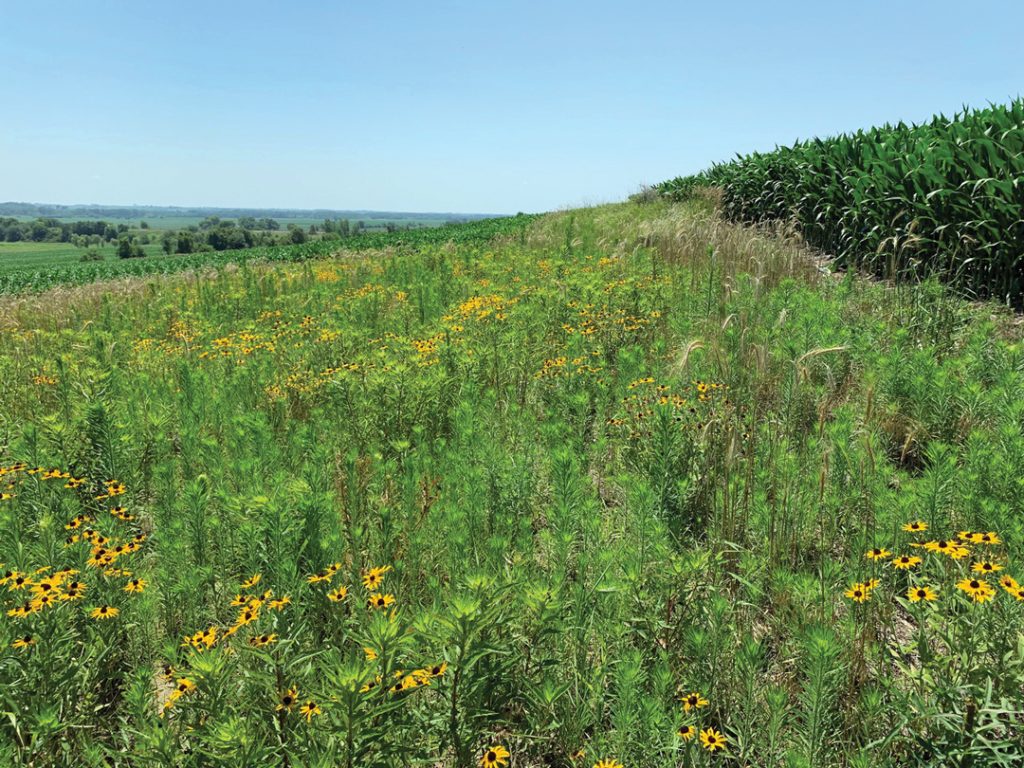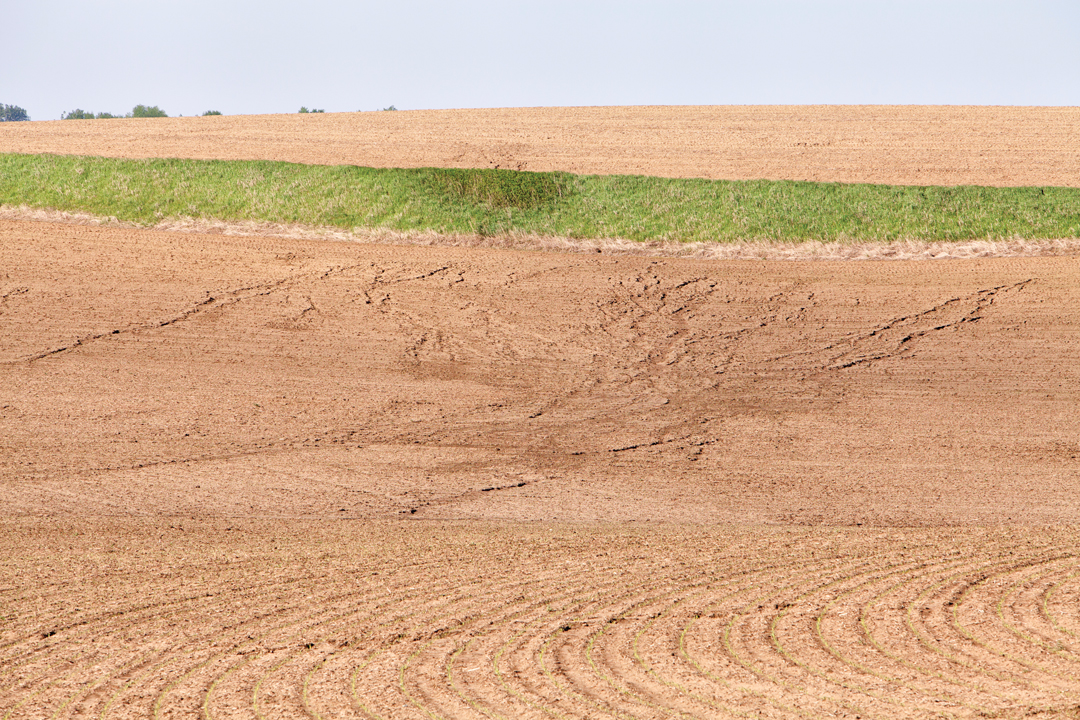PROFIT MARGINS
BY ADELINE PANAMAROFF • LEAD PHOTO COURTESY OF RICK CRUSE
Hedgerows, hillsides too steep for tractors to climb and even grassy margins along fencelines serve as havens for beneficial insects and birds that play a pivotal role in pest control. Since the dust bowl days of the 1930s, shelterbelts composed of trees and mixed vegetation have mitigated soil erosion by wind and water. More recently, research has been carried out to assess the additional benefits such uncropped land may provide.
Paul Galpern is an associate professor of ecology and evolutionary biology at the University of Calgary. Since 2015, he has monitored the biodiversity and potential pest control and pollinator benefits created by these uncultivated areas of Alberta farmland. Such marginal areas may include shelterbelts, wetlands, field margins, roadside ditches, treed areas and even patches of forage and pasture areas within or adjacent to crop fields. “We’re doing this because we know growers need economic reasons to conserve or create non-crop vegetation areas,” said Galpern. “It’s dollars to them, and I totally respect that. What this [research] shows is it doesn’t mean you’re going to get a lot richer if you create non-crop vegetation areas. It means that it’s probably going to even out [economically, over time].”
As the Canola Council of Canada is a major funder of Galpern’s research, his work focuses on the high-value crop. He has used the Prairie Precision Sustainability Network to employ monitoring systems to study the potential positive effects of existing and newly created natural marginal areas adjacent to cropland.
Using a variety of methods, Galpern’s team has measured the distance beneficial predatory insects and pollinators travel from uncropped areas into crops. They have used various traps to capture and count insects such as beetles, spiders and pollinators. An innovative, new method used to evaluate insect activity involves the use of green, plasticine caterpillars. Hungry insects leave bite marks in these decoys that can then be counted. Another method uses dead moth eggs glued to paper slips. Predatory insects signal their presence by eating the eggs.
The researchers identified a spillover effect that creates a halo of activity around natural areas. Insects, spiders and pollinators travel a certain distance into cropped land, which tends to have better pollination rates and pest control as a result.
Over a 10-year span, Galpern has used satellite imagery to identify farmland where such conservation measures may prove beneficial. His calculations consider the crops being grown, local weather conditions and predicted market demand for canola.
The imagery pinpoints land that has perennially underproduced. These areas can then be evaluated by the farmer, who decides whether to take them out of production. It may make economic sense to do so, such as when the cost of inputs outweighs a crop’s financial return. The cost to establish and maintain such natural areas is low and can tap into alternative revenue sources. Applicable financial incentives may include Ducks Unlimited Canada’s Marginal Areas Program and ALUS, which pays farmers for ecosystem services derived from their land. These can include carbon sequestration and creation of wildlife habitat. Carbon credit systems which are now in the works may also provide additional economic encouragement.
For a project summary of the Beneficial Insects Surveillance Network, visit the Canola Research Hub website. Galpern also encourages farmers to contact him at paul.galpern@ucalgary.ca to receive his research reports.

PRAIRIE STRIPS
Across the U.S. border, research of a similar nature has been ongoing since the early 2000s. Rick Cruse is a professor in the Agronomy Department of Iowa State University. He leads the Science-Based Trials of Rowcrops Integrated with Prairie Strips (STRIPS) program. Cruse defines a prairie strip as human constructed shelterbelts, natural waterways and riparian areas, pastureland, turnaround areas and areas along fencelines.
The research program focuses primarily on soil erosion. “The co-benefit is if you’re controlling soil erosion, you’re typically using management practices that have the benefit to ecological services, which includes wildlife,” said Cruse. STRIPS has monitored the filtering effect prairie strips have on runoff. “The vegetated strips are a great filter when they’re combined with other practices—grassed waterways, for example. They have very positive soil and water effects, as well as the ecological effects.”
The soil development rate for Iowa is about one imperial ton per acre per year, said Cruse. However, when poorly managed, land in the flat, central area of the state may lose five tons to erosion in a bad year. In the lush hills and long slopes of western Iowa, the rate can run an alarming 30 to 50 tons. Erosion mitigation methods include crop rotation, terracing, cultivation of close-growing crops as well as conversion of cropland to pasture. Prairie strips additionally increase biodiversity of insects, birds and small vertebrates, said Cruse.
Maintenance of these areas does require concerted management. “They’re challenging to manage because anything that is Roundup Ready, anything that you spray will kill basically anything except [crops]. You have to groom those pretty well,” said Cruse.
While uptake has been modest, the USDA Natural Resources Conservation Service provides guidelines and financial incentives to U.S. farmers who install prairie strips between 30 and 120 feet wide.
Feedback from farmers who have adopted the practice is generally glowing. One such farmer is Maggie McQuown of Resilient Farms, a small corn, soybean and market garden operation in southwest Iowa. Having used prairie strips since 2014, she is pleased with the results. “Having perennial roots in the ground 365 days a year is very helpful, especially on degraded and sloping land,” said McQuown. She has also seen a vast increase in wildlife and pollinators on her property.
Upon request, the USDA will conduct a soil and elevation analysis and build a farm-specific plan to create prairie strips for maximum benefit. Typically, this may be as much as 10 per cent of the cropped area. Dependent upon soil quality, incentive payments can range from $150 to $300 USD per acre, McQuown estimated.
Farmers who wish to use prairie strips should look at the long-range benefits, five to 10 years down the line, she said. “Make sure they research what were the native grasses and forbs that were there prior to settlement and try to use the seed mix and select the types of plants to match what was originally in that area as much as possible.”
While farmers may be reluctant to take land out of production, the maintenance or creation of uncropped areas can benefit soil health, crop yield and their bottom line.







Comments